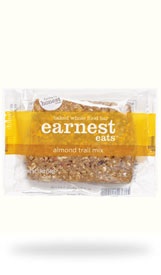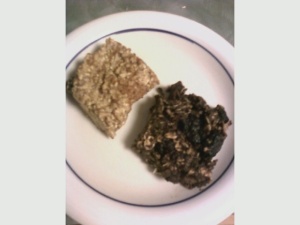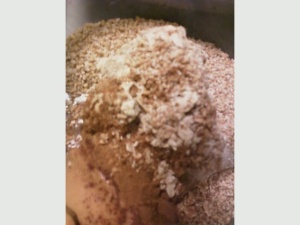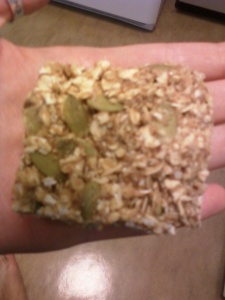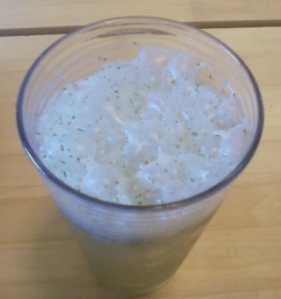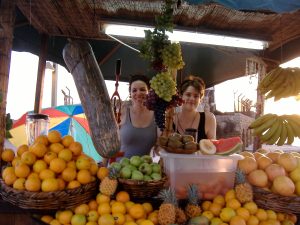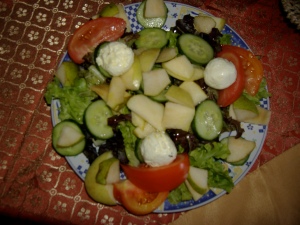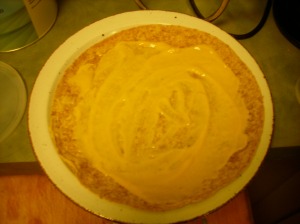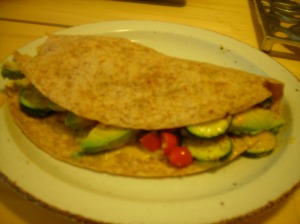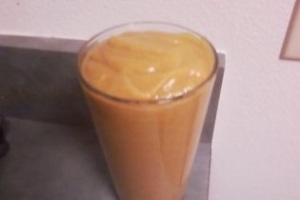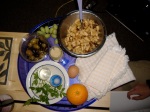Recipes for homemade vegan energy bars/ granola bars have been circulating the blogosphere recently, and I finally got around to making my own. I am very picky about energy bars- they are so packed with intense flavors and textures and at the same time can feel pretty homogenous. I find some bars too fruity, some too nutty, some too sweet, and some not sweet enough. Overall, though, I think the main problem is that I don’t find the ingredients fresh enough in taste.
I do want to briefly point out one glaring exception: Earnest Eats (http://earnesteats.com/our-foods/bars.php). These bars are made locally in Solana Beach. Our favorite is the almond trail mix bar: almond butter, oats, dried apricots and cranberries, sunflower seeds, and walnuts. Nutty but not too nutty (and without too many nut pieces), oat-y, sweet, and very fresh tasting. Rachel is such a big fan that she signed up for an amazon subscription to these! Each month we receive two packages of them.
Even at the discounted amazon price, however, these are not cheap- at least not nearly as cheap as making them yourself. My next energy bar recipe will be to emulate the almond trail mix Earnest Eats bar (or Almond Eats, as I usually mistakenly refer to it). In the mean time, several of my own bar creations:
Recipe #1: Cherry Molasses Energy Bars
1/2 cup dried bing cherries (mine came from Trader Joes)
1 1/3 cup rolled oats
1 cup nut butter ( I used half almond butter and half ground pecans)
1 heaping tbsp of coconut oil
1/2 cup molasses (this turned out to be very strong. Start with 1/4 cup and add to taste)
1/4 cup ground flax seed
Instructions: Mix it all together really well! Then press into a pan, however thick you want your bars, and freeze. Freezing helps the bars stick together and keeps them fresh until you want to cut one out and eat. That’s it!
I froze recipes #1 and #2 side by side in a baking pan:
Is it just me, or is saran wrap not clingy AT ALL these days?
Cut into delicious bars:
That’s the molasses bar on the right. In my opinion the molasses bar was the big winner. Cherry, pecan, coconut, & molasses = yum. The banana bar (recipe below) was good but because I used steel cut oats (I recommend rolled oats instead) they were a little too chewy.
Recipe #2: Banana peanut butter bars
1 banana, mashed
1 cup oats
1/2 cup peanut butter
1/4 cup honey
1/4 cup ground flax seed
1 tsp cinnamon
Instructions: you know what to do! (see Recipe #1)
My bars from recipes #1 and #2 are almost gone, and I am going hiking tonight, so I decided to make my third batch! The banana in recipe #2 made the bars a little gooey when out of the freezer for long, so I decided to make a peanut butter/oat/honey bar with banana.
Peanut butter honey energy bars:
1 cup oats
1/3 cup peanut butter (because I ran out- I recommend more for better texture)
1/4 cup honey
1/4 cup pumpkin seeds
1/4 cup ground flax seeds
maple syrup- drizzle in while mixing until desired texture is reached
My bars were slightly dry and crumbly since I was running out of peanut butter, but with a little extra maple syrup and getting firmly pressed into pan to freeze they came out perfectly: salty, sweet, nutty, oat-y, and a bit of pumpkin flavor.
I am soo excited to take these hiking tonight- I think they’ll taste even better halfway up a mountain!
I have been pleasantly surprised how easy and forgiving these bars are. If they are too moist add more oats or flax- if to dry, add a banana or sweetener of your choice (honey, molasses, agave, etc). For more texture add seeds or dried fruit. Oats, peanut butter, and bananas are also inexpensive foods, and make a delicious bar with our without the more gourmet add-ins. Verdict: totally sold! More more ideas check out Gena’s raw and vegan dehydrated energy bars (http://www.choosingraw.com/dehydrator-free-raw-vegan-energy-bars/) and Averie’s “no-bake vegan peanut butter chocolate chip protein” bars (http://www.loveveggiesandyoga.com/2010/01/vegan-peanut-butter-choc-chip-protein.html).
